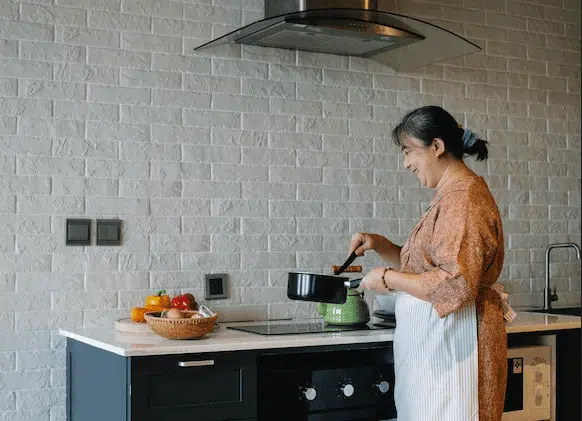Helping Older Adults Overcome Age-Related Loss of Appetite
Posted in Senior Health Care Tips
Changes in our bodies are natural results of the aging process. Due to decreased activity levels and changes to the metabolism, many older adults report slight decreases in their appetite starting as early as age 60. 
While minor changes to appetite are not a major source of concern, maintaining a balanced, nutritious diet is a key factor in promoting long-term health. Fortunately, a little creativity in the kitchen can go a long way towards ensuring less food (and associated health benefits) are left on the table. Read on to learn more.
-
Don’t ignore major changes in appetite or weight
While a gradual decrease in appetite can be normal, certain age-related medical complications can contribute to sudden change in weight and/or interest in food. These include:
- Difficulty grocery shopping, preparing meals, or using utensils.
- Difficulty chewing due to dental issues, dentures, or dry mouth.
- Dehydration, which can contribute to low appetite.
- New medications that may impact hormonal balance.
- Gastrointestinal changes that make digesting uncomfortable.
- Loss of smell or taste.
If you notice sudden, major changes in appetite or weight for yourself or a loved one, consider scheduling a doctor’s visit. To make the visit more beneficial, think about documenting everything you eat and drink in the days prior to your visit so your medical team has a better sense of your eating habits.
-
Add exercise to the menu
Try to work a walk around the neighborhood, household chores, or low-impact exercise into your daily routine. Regular physical exercise can help maintain a steadier metabolism and make it easier to clean your plate.
-
Consider smaller, more frequent meals
While many swear by three square meals a day, a lowered appetite means you may be leaving a lot of critical nutrients and calories on your plate. Consider expanding your menu plans to include five smaller meals every day. Doing so will make it easier to clean your plate and avoid the uncomfortable feeling of being too full after a large meal.
-
Embrace the spice rack
Many older adults report decreased smell and taste as they age. Naturally, this means it can be a lot harder to get excited about a meal when every bite tastes the same.
While many older-adult-friendly cookbooks recommend boiled or steamed dishes as healthier alternatives to roasting or frying, they often skimp on seasoning. Consider adding low-sodium spices like basil, rosemary, and paprika to your dishes to give them a bit more personality and make it easier to enjoy the flavors.
-
Put color on your plate
In addition to tasting bland, steamed and boiled foods rarely have the looks to inspire an appetite.
To add a bit more spark to your dishes, consider shopping for brighter foods, or including more colorful flourishes to a meal. Anything from sweet potatoes, fresh greens, slices of tomato, avocados, or fresh fruit can take a dish from “beige” to “bellissimo,” while providing vital nutrients and antioxidants.
-
Make meals bite-sized or finger-friendly
Decreased manual dexterity can make working with traditional eating utensils a frustrating or even embarrassing process for some older adults.
Rather than serving meals that require extensive use of utensils, consider serving food that can be eaten by hand, or is already cut into bite-sized portions. Additionally, sandwiches keep well and require no utensils to eat, making them ideal for people who struggle with traditional eating utensils.
Not all meals can easily be made finger-friendly, so purchasing utensils with thicker grips can help those with limited fine motor function continue to feed themselves and maintain independence longer.
-
Dinner with friends
While a table for one can be fun, nearly every culture on the planet sees eating as a social activity. Having a friend at the dinner table can make the process of meal preparation and eating much more enjoyable and encourage an older adult to spend more time eating than if they are passively watching television.
Enjoying a meal with company is also a wonderful way to remain socially engaged and lower an older adult’s risk of social isolation and loneliness, which carry their own significant health hazards.
-
Label leftovers
Saving leftovers is a great way to ensure a healthy snack is never farther than a quick trip to the refrigerator, but some care and organization is required.
When packing away leftovers, write the date that the food was cooked on the outside of the food container in large, visible handwriting to avoid accidentally eating spoiled food and potentially experiencing food poisoning or other possible health hazards. Because an older adult may not have the same sense of taste and smell they once had, good labeling is the most reliable way to avoid eating food that’s gone bad.
Additionally, set aside a few minutes twice a week to check your refrigerator for old leftovers and toss anything that has sat for more than 3 to 4 days.
We hope these tips help keep things more engaging at the dinner table. Maintaining a healthy, regular diet can be a challenge at any age, but the assistance of a dedicated home caregiver has been an absolute lifeline for many of our clients.
A home health caregiver can shop for groceries, cook meals in line with your nutritional needs and preferences, and keep you company at the table, allowing you to worry less about your next meal and focus on what’s most important to you.
To learn more about SelectCare and how we have helped older adults live healthier, happier lives in their long-time homes for nearly 40 years, call SelectCare today or request a free in-home care guide.
